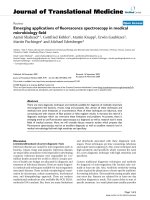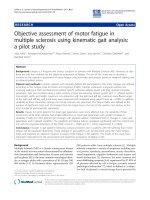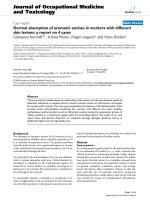Báo cáo hóa học: "EXPONENTIAL DICHOTOMY OF DIFFERENCE EQUATIONS IN l p -PHASE SPACES ON THE HALF-LINE" docx
Bạn đang xem bản rút gọn của tài liệu. Xem và tải ngay bản đầy đủ của tài liệu tại đây (571.82 KB, 14 trang )
EXPONENTIAL DICHOTOMY OF DIFFERENCE EQUATIONS
IN l
p
-PHASE SPACES ON THE HALF-LINE
NGUYEN THIEU HUY AND VU THI NGOC HA
Received 14 November 2005; Revised 12 March 2006; Accepted 17 May 2006
For a sequence of bounded linear operators
{A
n
}
∞
n=0
onaBanachspaceX,weinvestigate
the characterization of exponential dichotomy of the difference equations v
n+1
= A
n
v
n
.
We characterize the exponential dichotomy of difference equations in terms of the exis-
tence of solutions to the equations v
n+1
= A
n
v
n
+ f
n
in l
p
spaces (1 ≤ p<∞). Then we
apply t he results to study the robustness of exponential dichotomy of difference equa-
tions.
Copyright © 2006 N. T. Huy and V. T. N. Ha. This is an open access article distributed
under the Creative Commons Attribution License, which permits unrestricted use, dis-
tribution, and reproduction in any medium, provided the original work is properly cited.
1. Introduction and preliminaries
We consider the difference equation
x
n+1
= A
n
x
n
, n ∈ N, (1.1)
where A
n
, n = 0,1,2, , is a sequence of bounded linear operators on a given Banach
space X, x
n
∈ X for n ∈ N.
One of the central interests in the a symptotic behav ior of solutions to (1.1)istofind
conditions for solutions to (1.1) to be stable, unstable, and especially to have an exponen-
tial dichotomy (see, e.g., [1, 5, 7, 12, 16–20] and the references therein for more details
on the history of this problem). One can also use the results on exponential dichotomy
of difference equations to obtain characterization of exponential dichotomy of evolution
equations through the discretizing processes (see, e.g., [4, 7, 9, 18]).
One can easily see that if A
n
= A for all n ∈ N, then the asymptotic behavior of solu-
tions to (1.1) can be determined by the spectra of the operator A. However, the situation
becomes more complicated if
{A
n
}
n∈N
is not a constant sequence because, in this case,
the spectra of each operator A
n
cannot determine the asymptotic behavior of the solu-
tions to (1.1). Therefore, in order to find the conditions for (1.1)tohaveanexponential
dichotomy, one tries to relate the exponential dichotomy of (1.1) to the solvability of the
Hindawi Publishing Corporation
Advances in Difference Equations
Volume 2006, Article ID 58453, Pages 1–14
DOI 10.1155/ADE/2006/58453
2 Exponential dichotomy
following inhomogeneous equation:
x
n+1
= A
n
x
n
+ f
n
, n ∈ N, (1.2)
in some certain sequence spaces for each given f
={f
n
}. In other words, one wants to
relate the exponential dichotomy of (1.1) to the surjectiveness of the operator T defined
by
(Tx)
n
:= x
n+1
− A
n
x
n
for x =
x
n
belonging to a relevant sequence space. (1.3)
In the infinite-dimensional case, in order to characterize the exponential dichotomy of
(1.1)definedon
N, beside the surjectiveness of the operator T, one needs a priori con-
dition that the stable space is complemented (see, e.g., [5]). In our recent paper, we have
replaced this condition by the spectral conditions of related operators (see [9,Corollary
3.3]).
At this point, we would like to note that if one considers the difference equation (1.1)
defined on
Z, then the existence of exponential dichotomy of (1.1)isequivalenttothe
existence and uniqueness of the solution of ( 1.2)foragiven f
={f
n
}
n∈Z
, or, in other
words, to the invertibility of the operator T on suitable sequence spaces defined on
Z.
This means that one can drop the above priori condition in the case that the difference
equations are defined on
Z (see [7, Theorem 3.3] for the original result and see also [2,
3, 11, 15] for recent results on the exponential dichotomy of difference equations defined
on
Z).
However, if one considers the difference equation (1.1) defined only on
N, then t he
situation becomes more complicated, because for a given f
={f
n
}
n∈N
, the solutions of
the difference equation (1.2)on
N are not unique even in the case that the difference
equation (1.1) has an exponential dichotomy. Moreover, one does not have any informa-
tion on the negative half-line
Z
−
:={z ∈ Z : z ≤ 0} of the difference equations (1.1)and
(1.2) (we refer the readers to [8] for more details on the differences between the expo-
nential dichotomy of the differential equations defined on the half-line and on the whole
line). Therefore, one needs new ideas and new techniques to handle the exponential di-
chotomy of difference equations defined only on
N.Fordifferential equations defined on
the half-line, such ideas and techniques have appeared in [14](seealso[8, 13]). Those
ideas and techniques have been exploited to obtain the char acterization of exponential
dichotomy of difference equations defined on
N with l
∞
-phase space of sequences de-
fined on
N (see [9]). As a result, we have obtained a necessary and sufficient condition
for difference equations to have an exponential dichotomy. This conditions related to the
solvability of (1.2)inl
∞
spaces of sequences defined on N. In the present paper, we will
characterize the exponential dichotomy of (1.1) by the solvability of (1.2)inl
p
spaces
(1
≤ p<∞)ofsequencesdefinedonN. Moreover, we also characterize the exponential
dichotomy by invertibility of a certain appropriate difference operator derived from the
operator T. Consequently, we will use this characterization to prove the robustness of ex-
ponential dichotomy under small perturbations. Our results are contained in Theorems
3.2, 3.6, 3.7,andCorollary 3.3.
To describe more detailedly our construction, we will use the following notation: in
this paper X denotes a given complex Banach space endowed with the norm
·.As
N. T. Huy and V. T. N. Ha 3
usual, we denote by
N, R, R
+
,andC the sets of natural, real, nonnegative real, and com-
plex numbers, respectively. Throughout this paper, for 1
≤ p<∞ we will consider the
following sequence spaces:
l
p
(N,X):=
v =
v
n
n∈N
: v
n
∈ X :
∞
n=0
v
n
p
< ∞
:= l
p
,
l
0
p
(N,X):=
v =
v
n
: v ∈ l
p
; v
0
= 0
:= l
0
p
(1.4)
endowed with the norm
v
p
:= (
∞
n=0
v
n
p
)
1/p
.
Let
{A
n
}
n∈N
be a sequence of bounded linear operators from X to X whichisuni-
formly bounded. This means that there exists M>0suchthat
A
n
x≤Mx for all
n
∈ N and x ∈ X. Next we define a discrete evolution family ᐁ = (U
n,m
)
n≥m≥0
associated
with the sequence
{A
n
}
n∈N
as follows:
U
m,m
= Id (the identity operator in X)
U
n,m
= A
n−1
A
n−2
···A
m
for n>m.
(1.5)
The u niform boundedness of
{A
n
} yields the exponential boundedness of the evolu-
tion family (U
n,m
)
n≥m≥0
. That is, there exist positive constants K, α such that U
n,m
x≤
Ke
α(n−m)
x; x ∈ X; n ≥ m ≥ 0.
Definit ion 1.1. Equation (1.1)issaidtohaveanexponential dichotomy if there exist a
family of projections (P
n
)
n∈N
on X and positive constants N, ν such that
(1) A
n
P
n
= P
n+1
A
n
;
(2) A
n
:kerP
n
→ kerP
n+1
is an isomorphism and its inverse is denoted by A
−1
|n
;
(3)
U
n,m
x≤Ne
−ν(n−m)
x; n ≥ m ≥ 0; x ∈ P
m
X;
(4) denote U
|m,n
= A
−1
|m
A
−1
|m+1
···A
−1
|n−1
; n>m,andU
|m,m
= Id, then
U
|m,n
x
≤
Ne
−ν(n−m)
x, n ≥ m ≥ 0; x ∈ kerP
n
. (1.6)
The above family of projections (P
n
)
n∈N
is called the family of dichotomy projections.
We define a linear operator T as follows:
If u
=
u
n
∈
l
p
set (Tu)
n
= u
n+1
− A
n
u
n
for n ∈ N. (1.7)
For u
={u
n
}∈l
p
,wehave(Tu)
n
=u
n+1
− A
n
u
n
≤u
n+1
+ Mu
n
,henceTu ∈ l
p
and Tu
p
≤ (1 + M)u
p
. This means that T is a bounded linear operator from l
p
into
l
p
. We denote the restriction of T on l
0
p
by T
0
, this means that D(T
0
) = l
0
p
and T
0
u = Tu
for u
∈ l
0
p
. From the definition of T, the following are obvious.
Remark 1.2. (i) kerT
={u ={u
n
}∈l
p
: u
n
= U
n,0
u
0
, n ∈ N}.
(ii) It is easy to verify that T
0
is injective. Indeed, let u ={u
n
}, v ={v
n
}∈l
0
p
and T
0
u =
T
0
v.Thenwehaveu
0
= v
0
= 0, u
1
= (T
0
v)
0
= v
1
, u
2
= A
1
u
1
+(T
0
u)
1
= A
1
v
1
+(T
0
v)
1
=
v
2
, , u
n+1
= A
n
u
n
+(T
0
u)
n
= A
n
v
n
+(T
0
v)
n
= v
n+1
,foralln ∈ N.Hence,u = v.
4 Exponential dichotomy
Recall that for an operator B on a Banach space Y, the approximate point spectrum
Aσ(B)ofB is the set of all complex numbers λ such that for every
> 0, there exists
y
∈ D(B)withy=1and(λ − B)y≤
.
In order to characterize the exponential stability and dichotomy of an evolution family,
we need the concept of l
p
-stable spaces defined as follows.
Definit ion 1.3. For a discrete evolution family ᐁ
= (U
m,n
)
m≥n≥0
, m,n ∈ N,onBanach
space X and n
0
∈ N, define the l
p
-stable space X
0
(n
0
)by
X
0
n
0
:=
x ∈ X :
∞
n=n
0
U
n,n
0
x
p
< ∞
. (1.8)
An orbit U
m,n
0
x for m ≥ n
0
≥ 0andx ∈ X
0
(n
0
)iscalledanl
p
-stable orbit.
2. Exponential stability
In this section we will give a sufficient condition for stability of l
p
-stable orbits of a dis-
crete evolution family ᐁ. The obtained results will be used in the next section to charac-
terize the exponential dichotomy of (1.1).
Theorem 2.1. Let the op erator T
0
defined as above satisfy the condition 0 ∈ Aσ(T
0
). Then
every l
p
-stable orbit of ᐁ is exponentially stable. Precisely, there exist positive constants N, ν
such that for any n
0
∈ N and x ∈ X
0
(n
0
),
U
n,n
0
x
≤
Ne
−ν(n−s)
U
s,n
0
x
, n ≥ s ≥ n
0
. (2.1)
Proof. Since 0
∈ Aσ(T
0
), we have that there exists a constant η>0suchthat
η
T
0
v
p
≥v
p
for v ∈ l
0
p
. (2.2)
To pro ve ( 2.1), we first prove that there is a positive constant l such that for any n
0
∈ N
and x ∈ X
0
(n
0
),
U
n,n
0
x
≤
l
U
s,n
0
x
, n ≥ s ≥ n
0
≥ 0. (2.3)
Fix n
0
∈ N, x ∈ X
0
(n
0
), and s ≥ n
0
.Taking
v
=
v
n
with v
n
:=
⎧
⎨
⎩
U
n,n
0
x for n>s,
0for0
≤ n ≤ s,
(2.4)
we have v
∈ l
0
p
. By definition of T
0
,wehave(T
0
v)
n
= v
n+1
− A
n
v
n
. This yields
T
0
v
n
=
⎧
⎪
⎪
⎪
⎨
⎪
⎪
⎪
⎩
0forn ≤ s − 1,
U
s+1,n
0
x for n = s,
0forn>s.
(2.5)
N. T. Huy and V. T. N. Ha 5
By inequality (2.2), we have
η
U
s+1,n
0
x
≥
∞
k=s
U
k,n
0
x
p
1/p
≥
U
n,n
0
x
for n>s≥ n
0
. (2.6)
Hence,
U
n,n
0
x
≤
η
U
s+1,n
0
x
=
η
U
s+1,s
U
s,n
0
x
≤
ηM
U
s,n
0
x
for n>s≥ n
0
. (2.7)
Putting l
= max{1,ηM},weobtain(2.3).
We now show that there is a number K
= K(η,l) > 0 such that for any n
0
∈ N and
x
∈ X
0
(n
0
),
U
s+n,n
0
x
≤
1
2
U
s,n
0
x
for n ≥ K, s ≥ n
0
. (2.8)
To pro v e (2.8), put u
n
:= U
n,n
0
x, n ≥ n
0
,andleta<bbe two natural numbers with a ≥ n
0
such that u
b
> 1/2u
a
.From(2.3), we obtain that
l
u
a
≥
u
n
>
1
2l
u
a
for a ≤ n ≤ b. (2.9)
Put now
v
=
v
n
with v
n
=
⎧
⎪
⎪
⎪
⎪
⎪
⎪
⎪
⎪
⎪
⎨
⎪
⎪
⎪
⎪
⎪
⎪
⎪
⎪
⎪
⎩
0for0≤ n ≤ a,
u
n
n
k=a+1
1
u
k
for a +1≤ n ≤ b,
u
n
b+1
k=a+1
1
u
k
for n ≥ b +1.
(2.10)
Then v
∈ l
0
p
. By definition of T
0
,wehave
T
0
v =
T
0
v
n
with
T
0
v
n
=
⎧
⎪
⎪
⎪
⎪
⎪
⎨
⎪
⎪
⎪
⎪
⎪
⎩
0, for 0 ≤ n<a,
u
n+1
u
n+1
for a ≤ n ≤ b − 1,
0forn
≥ b.
(2.11)
By inequality (2.2), we obtain
η(b
− a)
1/p
≥v
p
. (2.12)
Using H
¨
older inequality for v and χ
[a+1,b]
,where
χ
[a+1,b]
n
=
⎧
⎨
⎩
1fora +1≤ n ≤ b,
0 otherwise ,
(2.13)
6 Exponential dichotomy
we have that
b
n=a+1
v
n
≤
(b − a)
1−1/p
v
p
. (2.14)
Substituting this into inequality (2.12), we obtain that
η(b
− a) ≥
b
n=a+1
v
n
. (2.15)
Using now the estimates (2.9), we have
η(b
− a) ≥
b
n=a+1
v
n
=
b
n=a+1
n
k=a+1
u
n
u
k
≥
b
n=a+1
1
2l
u
a
n
k=a+1
1
l
u
a
=
(b − a)(b − a +1)
4l
2
>
(b
− a)
2
4l
2
.
(2.16)
This yields b
− a<4ηl
2
.PuttingK := 4ηl
2
, the inequality (2.1)follows.
We finish by proving (2.1). Indeed, if n
≥ s ≥ n
0
∈ N writing n − s = n
1
K + r for 0 ≤
r<K,andn
1
∈ N,wehave
U
n,n
0
x
=
U
n−s+s,n
0
x
=
U
n
1
K+r+s,n
0
x
by (2.8)
≤
1
2
n
1
U
r+s,n
0
x
by (2.3)
≤
l
2
n
1
U
s,n
0
x
≤
2le
−((n−s)/K)ln2
U
s,n
0
x
.
(2.17)
Tak in g N :
= 2l and ν := ln 2/K, the inequality (2.1)follows.
From this theorem, we obtain the following corollary.
Corollary 2.2. Under the conditions of Theorem 2.1, the space X
0
(n
0
) can be expressed as
X
0
n
0
=
x ∈ X :
U
n,n
0
x
≤
Ne
−ν(n−n
0
)
x; n ≥ n
0
≥ 0
, (2.18)
for certain positive constants N, ν.Hence,X
0
(n
0
) is a closed linear subspace of X.
3. Exponential dichotomy and perturbations
We will characterize the exponential dichotomy of (1.1) by using the operators T
0
, T.In
particular, we will also get necessary and sufficient conditions for exponential dichotomy
in Hilbert spaces and finite-dimensional spaces. Moreover, using our characterization of
the exponential dichotomy, we can prove the robustness of the exponential dichotomy
of (1.1) under small perturbations. Then we start with the following lemma which has a
history that can be tr aced back to [14, Lemma 4.2] and to [6] and beyond.
Lemma 3.1. Assume that (1.1) has an exponential dichotomy with corresponding family of
projections P
n
, n ≥ 0, and constants N>0, ν > 0, then M := sup
n≥0
P
n
< ∞.
N. T. Huy and V. T. N. Ha 7
Proof. The proof is done in [9, Lemma 3.1]. We present it here for sake of completeness.
Fix n
0
> 0, and set P
0
:= P
n
0
; P
1
:= Id−P
n
0
, X
k
= P
k
X, k = 0,1. Set γ
0
:= inf{x
0
+ x
1
:
x
k
∈ X
k
, x
0
=x
1
=1}.Ifx ∈ X and P
k
x = 0, k = 0,1, then
γ
n
0
≤
P
0
x
P
0
x
+
P
1
x
P
1
x
≤
1
P
0
x
P
0
x +
P
0
x
P
1
x
P
1
x
≤
1
P
0
x
x +
P
0
x
−
P
1
x
P
1
x
P
1
x
≤
2
x
P
0
(x)
.
(3.1)
Hence,
P
0
≤2/γ
n
0
. It remains to show that there is a constant c>0 (independent of n
0
)
such that γ
n
0
≥ c. For this, fix x
k
∈ X
k
, k = 0,1, with x
k
=1. By the exponential bound-
edness of ᐁ,wehave
U
n,n
0
(x
0
+ x
1
)≤Ke
α(n−n
0
)
x
0
+ x
1
for n ≥ n
0
and constants K,
α
≥ 0. Thus,
x
0
+ x
1
≥
K
−1
e
−α(n−n
0
)
U
n,n
0
x
0
+ U
n,n
0
x
1
≥
K
−1
e
−α(n−n
0
)
N
−1
e
ν(n−n
0
)
− Ne
−ν(n−n
0
)
=
: c
n−n
0
,
(3.2)
and hence γ
n
0
≥ c
n−n
0
.Obviouslyc
m
> 0form sufficiently large. Thus 0 <c
m
≤ γ
n
0
.
Now we come to our first main result. It characterizes the exponential dichotomy of
(1.1) by properties of the operator T.
Theorem 3.2. Let
{A
n
}
n∈N
be a family of bounded linear and uniformly bounded operators
on the Banach space X. Then the following assertions are equivalent.
(i) Equation (1.1) has an exponential dichotomy.
(ii) T is surjective and X
0
(0) is complemented in X.
Proof. (i)
⇒(ii). Let (P
n
)
n≥0
be the family of dichotomy projections. Then X
0
(0) = P
0
X,
and hence X
0
(0) is complemented. If f ∈ l
p
,definev ={v
n
}
n∈N
by
v
n
=
⎧
⎪
⎪
⎪
⎪
⎪
⎪
⎨
⎪
⎪
⎪
⎪
⎪
⎪
⎩
n
k=1
U
n,k
P
k
f
k−1
−
∞
k=n+1
U
|n,k
Id −P
k
f
k−1
for n ≥ 1,
−
∞
k=1
U
|0,k
Id −P
k
f
k−1
for n = 0,
(3.3)
then v
n+1
= A
n
v
n
+ f
n
. Moreover, since
n
k=1
U
n,k
P
k
f
k−1
−
∞
k=n+1
U
|n,k
Id −P
k
f
k−1
≤
N
∞
k=1
e
−ν|n−k|
f
k−1
(3.4)
and f
∈ l
p
, we can easily derive that v ∈ l
p
. By the definition of T,wehaveTv = f .There-
fore T : l
p
→ l
p
is surjective.
8 Exponential dichotomy
(ii)
⇒(i). We prove this in several steps.
(A) Let Z
⊆ X be a complement of X
0
(0) in X, that is, X = X
0
(0) ⊕ Z.SetX
1
(n) =
U
n,0
Z.Then
U
n,s
X
0
(s) ⊆ X
0
(n), U
n,s
X
1
(s) = X
1
(n), n ≥ s ≥ 0. (3.5)
(B) There are constants N,ν > 0suchthat
U
n,0
x
≥
Ne
ν(n−s)
U
s,0
x
for x ∈ X
1
(0), n ≥ s ≥ 0. (3.6)
In fact, let Y :={(v
n
)
n∈N
∈ l
p
: v
0
∈ X
1
(0)} endowed with l
p
-norm. Then Y is a closed
subspace of the Banach space l
p
, and hence Y is complete. By Remark 1.2,wehavekerT :=
{
v ∈ l
p
: v
n
= U
n,0
x for some x ∈ X
0
(0)}.SinceX = X
0
(0) ⊕ X
1
(0) and T is surjective, we
obtain that
T : Y −→ l
p
(3.7)
is bijective and hence an isomorphism. Thus, by Banach isomorphism theorem, there is
aconstantη>0suchthat
η
Tv
p
≥v
p
,forv ∈ Y. (3.8)
To pro ve ( 3.6), we first prove that there is a positive constant l such that
U
n,0
x
≥
l
U
s,0
x
for x ∈ X
1
(0), n ≥ s ≥ 0, n,s ∈ N. (3.9)
Indeed, fix x
∈ X
1
(0), x = 0, and n ≥ s ≥ 0. If n = 0, there is nothing to do. So, assume
that n
≥ 1. Now taking
v :
=
v
m
with v
m
:=
⎧
⎨
⎩
U
m,0
x for 0 ≤ m ≤ n − 1,
0form>n
− 1,
(3.10)
we have that v
∈ Y. Then, by definition of T,weobtainthat
(Tv)
m
:=
⎧
⎪
⎪
⎪
⎨
⎪
⎪
⎪
⎩
0form>n− 1,
−U
n,0
x for m = n − 1,
0form<n
− 1.
(3.11)
Inequality (3.8)yields
η
U
n,0
x
≥
⎛
⎝
n−1
k=0
U
k,0
x
p
⎞
⎠
1/p
≥
U
s,0
x
∀
0 ≤ s ≤ n − 1. (3.12)
Putting now l := min{1/η,1}, inequality (3.9)follows.
N. T. Huy and V. T. N. Ha 9
We now show that there is a number K
= K(η,l) > 0suchthat
U
s+n,0
x
≥
2
U
s,0
x
for n ≥ K, s ≥ 0; x ∈ X
1
(0). (3.13)
Let 0
= x ∈ X
1
(0), set u
n
:= U
n,0
x, n ≥ 0. By Remark 1.2 we h ave u
n
= 0foralln ≥ 0. To
prove (3.13), let a<bbe two natural numbers such that
u
b
< 2u
a
.From(3.9), we
obtain that
2
l
u
a
>
u
n
≥
l
u
a
∀
a ≤ n ≤ b. (3.14)
Take now v
={v
n
},where
v
n
=
⎧
⎪
⎪
⎪
⎪
⎪
⎪
⎪
⎪
⎪
⎨
⎪
⎪
⎪
⎪
⎪
⎪
⎪
⎪
⎪
⎩
−
u
n
b
k=a+1
1
u
k
for 0 ≤ n<a,
−u
n
b
k=n+1
1
u
k
for a ≤ n<b,
0forn
≥ b.
(3.15)
Then, v
∈ Y. By definition of T,wehavethat
(Tv)
n
=
⎧
⎪
⎪
⎪
⎪
⎪
⎨
⎪
⎪
⎪
⎪
⎪
⎩
0for0≤ n<a,
u
n+1
u
n+1
for a ≤ n<b,
0forn
≥ b.
(3.16)
By inequality (3.8), we obtain
η(b
− a)
1/p
≥v
p
. (3.17)
Using H
¨
older inequality for v and χ
[a,b−1]
,where
χ
[a,b−1]
n
=
⎧
⎨
⎩
1fora ≤ n ≤ b − 1,
0 otherwise ,
(3.18)
we have that
b−1
n=a
v
n
≤
(b − a)
1−1/p
v
p
. (3.19)
Substituting this into inequality (3.17), we obtain that
η(b
− a) ≥
b−1
n=a
v
n
. (3.20)
10 Exponential dichotomy
Using now the estimates (3.14), we have
η(b
− a) ≥
b−1
n=a
v
n
=
b−1
n=a
b
k=n+1
u
n
u
k
≥
b−1
n=a
l
u
a
b
k=n+1
l
2
u
a
=
l
2
(b − a)(b − a +1)
4
>
l
2
(b − a)
2
4
.
(3.21)
This yields b
− a<4η/l
2
.PuttingK := 4η/l
2
, the inequality (3.13)follows.
We finish this step by proving inequality (3.6). Indeed, if n
≥ s ∈ N,writingn − s =
n
0
K + r for 0 ≤ r<K,andn
0
∈ N,wehave
U
n,0
x
=
U
n−s+s,0
x
=
U
n
0
K+r+s,0
x
by (3.13)
≥ 2
n
0
U
r+s,0
x
by (3.9)
≥ l2
n
0
U
s,0
x
≥
l
2
e
((n−s)/K)ln2
U
s,0
x
.
(3.22)
Tak in g N :
= l/2andν := ln2/K, inequality (3.6)follows.
(C) X
= X
0
(n) ⊕ X
1
(n), n ∈ N.
Let Y
⊂ l
p
be as in (B). Then by Remark 1.2,wehavethatl
0
p
⊂ Y. From this fact and
(3.8), we obtain that η
T
0
v
l
p
≥v
l
p
,forv ∈ l
0
p
.Thus,
0
∈ Aσ
T
0
. (3.23)
The relation (3.23)andCorollary 2.2 imply that X
0
(n)isclosed.From(3.5), (3.6), and
the closedness of X
1
(0), we can easily derive that X
1
(n)isclosedandX
1
(n) ∩ X
0
(n) ={0}
for n ≥ 0.
Finally, fix n
0
> 0, and x ∈ X (note that we already have X = X
0
(0) ⊕ X
1
(0)). For a
natural number n
1
>n
0
+1,set
v
=
v
n
with v
n
=
⎧
⎪
⎪
⎪
⎨
⎪
⎪
⎪
⎩
0for0≤ n<n
0
,
n − n
0
+1
U
n,n
0
x for n
0
≤ n ≤ n
1
,
0forn>n
1
,
f
=
f
n
with f
n
=
⎧
⎪
⎪
⎪
⎪
⎪
⎪
⎪
⎨
⎪
⎪
⎪
⎪
⎪
⎪
⎪
⎩
0for0≤ n<n
0
,
U
n+1,n
0
x for n
0
≤ n<n
1
,
−
n
1
− n
0
+1
U
n+1,n
0
x for n = n
1
,
0forn>n
1
.
(3.24)
Then v, f
∈ l
p
and satisfy (1.2)foralln ≥ n
0
> 0. By assumption, there exists w ∈ l
p
such
that Tw
= f . By the definition of T, w
n
is a solution of (1.2). Thus,
v
n
− w
n
= U
n,n
0
v
n
0
− w
n
0
=
U
n,n
0
x − w
n
0
, n ≥ n
0
. (3.25)
N. T. Huy and V. T. N. Ha 11
Since v
− w ∈ l
p
,wehavethatx − w
n
0
∈ X
0
(n
0
). On the other hand, since w
0
= w
0
+
w
1
with w
k
∈ X
k
(0), w
n
0
= U
n
0
,0
w
0
+ U
n
0
,0
w
1
,andby(3.5), we have U
n
0
,0
w
k
∈ X
k
(n
0
),
k
= 0,1. Hence x = x − w
n
0
+ w
n
0
= x − w
n
0
+ U
n
0
,0
w
0
+ U
n
0
,0
w
1
∈ X
0
(n
0
)+X
1
(n
0
). This
proves (C).
(D) Let P
n
be the projections from X onto X
0
(n)withkernelX
1
(n), n ≥ 0. Then (3.5)
implies that P
n+1
U
n+1,n
= U
n+1,n
P
n
,orA
n
P
n
= P
n+1
A
n
for n ≥ 0. From (3.5), (3.6), and
A
n
= U
n+1,n
,weobtainthatA
n
:kerP
n
→ ker P
n+1
, n ≥ 0 is an isomorphism. Finally, by
(3.6), Theorem 2.1, and the assumption 0
∈ Aσ(T
0
), there exist constants N, ν > 0such
that
U
n,m
x
≤
Ne
−ν(n−m)
x for x ∈ P
m
X, n ≥ m ≥ 0,
U
|m,n
x
≤
Ne
−ν(n−m)
x for x ∈ kerP
n
, n ≥ m ≥ 0.
(3.26)
Thus (1.1) has an exponential dichotomy.
If X is a Hilbert space, we need only the closedness of X
0
(0). Therefore, we obtain the
following corollary.
Corollary 3.3. If X is a Hilbert space, then the conditions that 0
∈ Aσ(T
0
) and T is sur-
jective are necessary and sufficient for (1.1) to have an exponential dichotomy.
This can be restated as follows.
If X is a Hilbert space, then the conditions
(1) for all f
∈ l
p
, there exists a solution x ∈ l
p
of (1.2);
(2) there exists a constant c>0 such that all bounded solutions x
={x
n
} (w ith x
0
= 0
and x
∈ l
p
)of(1.2)(with f ∈ l
p
)satisfy
∞
n=0
x
n
p
≤ c
∞
n=0
f
n
p
are necessary and sufficient for (1.1) to have an exponential dichotomy.
Proof. The corollary is obvious in view of Corollary 2.2 and Theorem 3.2.
If X is a finite-dimensional space, then every subspace of X is closed and comple-
mented. Hence, by Theorem 3.2 we have the following corollar y.
Corollary 3.4. If X is a finite-dimensional space, then the condition that T is surjective is
necessary and sufficient for existence of exponential dichotomy of (1.1).
In our next result, we will characterize the exponential dichotomy of (1.1) using in-
vertibility of a certain operator derived from the operator T.Inordertoobtainsuch
a characterization, we have to know the subspace kerP
0
in advance (see Theorem 3.6).
Consequently, the exponential dichotomy of evolution family will be characterized by
the invertibility of the restriction of T to a certain subspace of l
p
. This restriction will be
defined as follows.
Definit ion 3.5. For a closed linear subspace Z of X,define
l
Z
p
:=
f =
f
n
∈
l
p
: f
0
∈ Z
. (3.27)
Then, l
Z
p
is a closed subspace of (l
p
,·
p
). Denote by T
Z
the part of T in l
Z
p
, that is,
D( T
Z
) = l
Z
p
and T
Z
u = Tu for u ∈ l
Z
p
.
12 Exponential dichotomy
With these notations, we obtain the following characterization of exponential dicho-
tomy of (1.1).
Theorem 3.6. Let
{A
n
}
n∈N
be a family of bounded linear and uniformly bounded opera-
tors on the Banach space X and let Z be a close d linear subspace of X. Then the following
assertions are equivalent.
(i) Equation (1.1) has an exponential dichotomy with the family of dichotomy projec-
tions
{P
n
}
n∈N
satisfying ker P
0
= Z.
(ii) T
Z
: l
Z
p
→ l
p
is invertible.
Proof. We first note t hat the following proof is inspired by the proof of [14, Theorem 4.5].
(i)
⇒(ii). Let P
n
, n ∈ N, be a family of projections given by the exponential dichotomy
of (1.1)suchthatkerP
0
= Z.ThenP
0
X = X
0
(0) and X = X
0
(0) ⊕ Z.Fix f ={f
n
}∈l
p
.By
Theorem 3.2, there is v
={v
n
}∈D(T)suchthatTv = f . On the other hand, by definition
of X
0
(0), the sequence u ={u
n
} defined by u
n
= U
n,0
P
0
v
0
belongs to l
p
. By definition of T,
we obtain that Tu
= 0. Moreover, v
0
− u
0
= v
0
− P
0
v
0
∈ Z since X = P
0
X ⊕ Z. Therefore,
v
− u ∈ l
Z
p
and T
Z
(v − u) = T(v − u) = Tv = f .Hence,T
Z
: D(T
Z
) → l
p
is surjective.
If now w
={w
n
}∈ker T
Z
then, by definition of T
Z
, w
n
= U
n,0
w
0
with w
0
∈ Z ∩ X
0
(0)=
{
0}.Thus,w = 0, that is, T
Z
is injective.
(ii)
⇒(i). Let T
Z
: l
Z
p
→ l
p
be invertible. Since T
Z
is the restriction of T to l
Z
p
,itfollows
that T is surjective. The boundedness of T
Z
implies that T
−1
Z
is bounded, and hence there
is η>0suchthatη
Tv
p
= ηT
Z
v
p
≥v
p
for all v ∈ l
Z
p
.SinceT
0
is the part of T
Z
in l
0
p
={f ∈ l
p
: f
0
= 0},weobtainthatηT
0
v
p
≥v
p
for all v ∈ D(T
0
). Hence, 0 ∈
Aσ(T
0
). By Corollary 2.2, X
0
(0) is closed. We now prove that X = X
0
(0) ⊕ Z.Letnowx ∈
X.IfU
n,0
x = 0forsomen = n
0
> 0, then U
n,0
x = U
n,n
0
U
n
0
,0
x = 0foralln ≥ n
0
yielding
x
∈ X
0
(0). Otherwise, U
n,0
x = 0foralln ∈ N.Setu ={u
n
} with
u
n
:=
⎧
⎨
⎩
x for n = 0
0forn>0,
f
=
f
n
with f
n
:=
⎧
⎨
⎩
−
A
0
x for n = 0
0forn>0.
(3.28)
Clearly, u
∈ l
p
, f ∈ l
p
,and f
n
= u
n+1
− A
n
u
n
. Therefore, Tu = f . On the other hand, since
T
Z
is invert ible, there exists v ∈ l
Z
p
such that T
Z
v = f = Tv.Thus,u − v ∈ kerT, and hence
(u
− v)
n
= U
n,0
u
0
− v
0
=
U
n,0
x − v
0
, n ∈ N. (3.29)
Since u
− v ∈ l
p
, this implies that x − v
0
∈ X
0
(0). Thus x = x − v
0
+ v
0
∈ X
0
(0) + Z.
If now y
∈ X
0
(0) ∩ Z, then the sequence w ={w
n
} defined by w
n
:= U
n,0
y, n ∈ N,
belongs to l
Z
p
∩ kerT (see definitions of X
0
(0) and T). Hence, T
Z
w = 0 and by invertibility
of T
Z
,wehavethatw = 0. Thus y = w
0
= 0, that is, X
0
(0) ∩ Z ={0}. This yields that
X
= X
0
(0) ⊕ Z. The assertion now follows from Theorem 3.2.
Using the above characterization of exponential dichotomy, we now study the robust-
ness of the exponential dichotomy of (1.1) under small perturbations. Precisely, we have
the following perturbation theorem.
Theorem 3.7. Let (1.1) have an exponential dichotomy and let
{B
n
}
n∈N
be a sequence of
bounded linear operators from X to X which is uniformly bounded (i.e., there is constant
N. T. Huy and V. T. N. Ha 13
M>0 such that
B
n
≤M for all n ∈ N). Then, if H := sup
n∈N
B
n
is sufficiently small,
the equation
u
n+1
=
A
n
+ B
n
u
n
(3.30)
has an exponential dichotomy as well.
Proof. Let (1.1) have an exponential dichotomy with the corresponding dichotomy pro-
jections (P
n
)
n∈N
.PutkerP
0
= Z.Then,Z is a closed subspace of X.ByTheorem 3.6,we
have that the operator T
Z
defined by Definition 3.5 is invertible. Let now T
B,Z
be the op-
erator corresponding to the perturbed difference equation (3.30). That is, T
B,Z
: l
Z
p
→ l
p
is defined by (T
B,Z
u)
n
= u
n+1
− (A
n
+ B
n
)u
n
. We now define the operator B by (B f )
n
:=
B
n
f
n
for f ={f
n
} and all n ∈ N.WethenprovethatB : l
p
→ l
p
is a bounded linear oper-
ator and
B≤H. Indeed, take f ∈ l
p
.Then(B f )
n
=B
n
f
n
≤H f
n
for all n ∈ N.
It follows that the sequence
B f belongs to l
p
and B f
p
≤ H f
p
.Wethusobtainthat
B : l
p
→ l
p
is a bounded linear operator and B≤H.
It is clear that T
B,Z
= T
Z
− B.SinceT
Z
is invertible, by a per turbation theorem of
Kato [10, IV.1.16], we obtain that if
B is sufficiently small then T
B,Z
= T
Z
− B is also
invertible. By Theorem 3.6 we have that (3.30) has an exponential dichotomy.
Acknowledgment
The second author would like to thank Professor Heinrich Begehr for moral support.
References
[1] B. Aulbach and N. V. Minh, The concept of spectral dichotomy for linear diffe rence equations. II,
Journal of Difference Equations and Applications 2 (1996), no. 3, 251–262.
[2] D. D. Bainov, S. I. Kostadinov, and P. P. Zabreiko, Stability of the notion of dichotomy of linear im-
pulsive differential equations in a Banach space, Italian Journal of Pure and Applied Mathematics
1 (1997), 43–50 (1998).
[3] A. G. Baskakov, Semigroups of difference operators in the spectral analysis of linear differential
operators, Functional Analysis and Its Applications 30 (1996), no. 3, 149–157 (1997).
[4] S N. Chow and H. Leiva, Existence and roughness of the exponential dichotomy for skew-product
semiflow in Banach spaces,JournalofDifferential Equations 120 (1995), no. 2, 429–477.
[5] C. V. Coffman and J. J. Sch
¨
affer, Dichotomies for linear difference equations, Mathematische An-
nalen 172 (1967), no. 2, 139–166.
[6] Ju. L. Dalec’ki
˘
ı and M. G. Kre
˘
ın, Stability of Solutions of Differential Equations in Banach Space,
Translations of Mathematical Monographs, vol. 43, American Mathematical Society, Rhode Is-
land, 1974.
[7] D. Henry, Geometric Theory of Semilinear Parabolic Equations, Lecture Notes in Mathematics,
vol. 840, Springer, Berlin, 1981.
[8] N.T.Huy,Exponential dichotomy of evolution equations and admissibility of function spaces on a
half-line, Journal of Functional Analysis 235 (2006), no. 1, 330–354.
[9] N. T. Huy and N. V. Minh, Exponential dichotomy of difference equations and applications to
evolution equations on the half-line, Computers & Mathematics with Applications 42 (2001),
no. 3–5, 301–311.
[10] T. Kato, Perturbation Theory for Linear Operators, Springer, New York, 1980.
14 Exponential dichotomy
[11] Y. Latushkin and Y. Tomilov, Fredholm differential operators with unbounded coefficients,Journal
of Differential Equations 208 (2005), no. 2, 388–429.
[12] T. Li, Die Stabilitatsfrage bei Differenzengleichungen,ActaMathematica63 (1934), 99–141.
[13] N. V. Minh and N. T. Huy, Characterizations of dichotomies of evolution equations on the half-line,
Journal of Mathematical Analysis and Applications 261 (2001), no. 1, 28–44.
[14] N. V. Minh, F. R
¨
abiger, and R. Schnaubelt, Ex ponential stability, exponential expansiveness, and
exponential dichotomy of evolution equations on the half-line, Integral Equations and Operator
Theory 32 (1998), no. 3, 332–353.
[15] P. H. A. Ngoc and T. Naito, New characterizations of exponential dichotomy and exp onential sta-
bility of linear difference equations,JournalofDifference Equations and Applications 11 (2005),
no. 10, 909–918.
[16] A.C.PetersonandY.N.Raffoul, Exponential stability of dynamic equations on time scales,Ad-
vances in Difference Equations 2005 (2005), no. 2, 133–144.
[17] A. Rodkina and H. Schurz, Global asymptotic stability of solutions of cubic stochastic difference
equations,AdvancesinDifference Equations 2004 (2004), no. 3, 249–260.
[18] G. R. Sell and Y. You, Dynamics of Evolutionary Equations, Applied Mathematical Sciences, vol.
143, Springer, New York, 2002.
[19] V. E. Slyusarchuk, Exponential dichotomy of solutions of discrete systems, Ukrainskiı Matematich-
eski
˘
ıZhurnal35 (1983), no. 1, 109–115, 137.
[20] G. Stefanidou and G. Papaschinopoulos, Trichotomy, stability, and oscillation of a fuzzy difference
equation,AdvancesinDifference Equations 2004 (2004), no. 4, 337–357.
Nguyen Thieu Huy: Department of Applied Mathematics, Hanoi University of Technology,
Khoa Toan Ung Dung, Dai Hoc Bach Khoa Ha Noi, 1 Dai Co Viet Street, Hanoi, Vietnam
E-mail address:
Vu Thi Ngoc Ha: Department of Applied Mathematics, Hanoi University of Technology,
Khoa Toan Ung Dung, Dai Hoc Bach Khoa Ha Noi, 1 Dai Co Viet Street, Hanoi, Vietnam
E-mail address:









